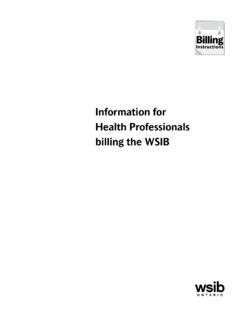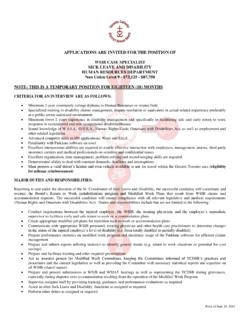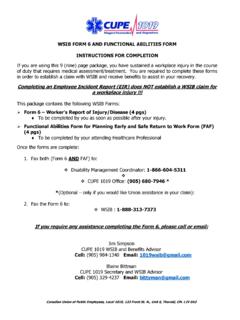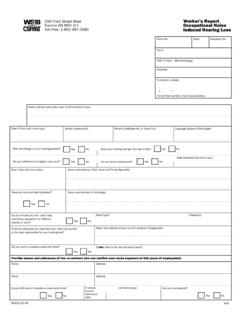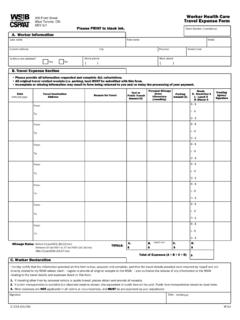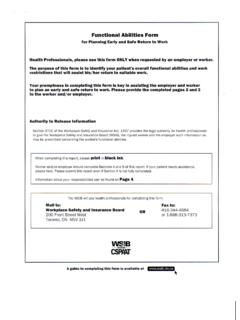Transcription of The Employer’s Guide to
1 Revised August 2011 The Employer s Guide to Workplace Safety and Insurance This Guide is designed to help non-construction employers (and construction employers with non-construction workers) manage workplace safety and insurance issues for their injured workers. It provides basic information and answers to frequently asked questions. Construction employers should also download The Construction Employer s Guide to Workplace Safety and Insurance from our website at , as the obligations regarding wsib coverage and re-employment for construction workers are different. Since the workplace safety and insurance system is complex, you may have more questions than we could include in this Guide . If you need help to apply this information to your particular situation, please contact us. Office of the Employer Adviser (OEA) 151 Bloor Street West, Suite 704 Toronto, Ontario M5S 1S4 Telephone: 416-327-0020 / 1-800-387-0774 Visit our website: Send us your e-mail questions: Subscribe to our free electronic newsletter: The information in this Guide is based on the Workplace Safety and Insurance Act, 1997, and subsequent amendments.
2 Queen s Printer for Ontario, 2013 ISBN 978-1-4606-0964-4 (PDF) The Employer s Guide to Workplace Safety and Insurance March 2013 The Employer s Guide to Workplace Safety and Insurance Table of Contents Office of the Employer Adviser .. 1 Introduction .. 1 Registration .. 1 Coverage .. 2 Employer Costs and Penalties .. 4 Independent Operators .. 7 Contracting Out .. 7 Accidents and Occupational Diseases .. 9 Work 14 Re-employment for Non-construction employers .. 22 Work Transition .. 26 Appeals .. 29 wsib Service Delivery Model .. 31 Glossary of Terms .. 36 Resources .. 41 Page 1 The Employer s Guide to Workplace Safety and Insurance March 2013 Office of the Employer Adviser The OEA and how it can help you The Office of the Employer Adviser (OEA) is an independent agency of the Ontario Ministry of Labour (MOL) and has been helping Ontario employers since 1985.
3 Our experts can help you manage workplace safety and insurance costs (formerly referred to as workers compensation ) to give your business a competitive advantage. We provide expert advice to any size employer, and represent primarily employers who employ fewer than 100 employees. We also offer information on our website. We don t charge any fees for our services because we are funded through the premiums or administration fees you pay to the Workplace Safety and Insurance Board ( wsib ). Introduction Overview of the workplace safety and insurance system Workplace safety and insurance is a no-fault insurance system for work-related injuries and diseases. It is governed by the Workplace Safety and Insurance Act, 1997 (WSIA), and is managed by the wsib . Registration Who needs to register with the wsib If you hire workers, including family members or apprentices, for your business you must register with the wsib within 10 days of hiring your first worker if you are in a compulsorily covered industry.
4 Likewise, if you acquire any or all of an existing compulsorily covered business with employees, you must register with the wsib within 10 days. You should always check with the wsib , preferably in writing, to determine whether or not you need to register. How to register Registration forms are available on the wsib s website at , and through its eRegistration service. You can also call the wsib at 1-800-387-0750 to have one sent to you. Precautions when acquiring an existing business If you acquire an existing business you will inherit the seller s accident history and financial obligations, including any money owed to the wsib . To protect yourself, you Page 2 The Employer s Guide to Workplace Safety and Insurance March 2013 should get a purchase certificate from the wsib . A purchase certificate is a document the wsib will issue if the original employer s account is in good standing, on the date the business is sold.
5 If a purchase certificate is issued, the wsib will not hold the purchaser liable for any amounts charged to the original owner s account, up to the date the business changed hands. For audit purposes, purchasers must keep a copy of any purchase certificate received. Both the purchaser and the vendor are required to keep a copy of any purchase certificate issued directly to them by the wsib . Registration for independent operators (IOs)/contractors who do not supply construction services If you have no employees, and meet the wsib s criteria for IO status, you are not required to register with the wsib . You should check with the wsib , preferably in writing, to determine whether or not you need to register. How to register Registration forms are available on the wsib s website or through its eRegistration service. You can also call the wsib at 1-800-387-0080 to have one sent to you. There currently are two types of registration processes depending on whether you are an employer, or an individual applying as an IO, a sole proprietor, a partner, or an executive officer of a corporation who does not work in the construction industry.
6 1. Employer registration This process is for a business that hires one or more workers. 2. Optional insurance request/change This is the voluntary registration process for IOs, sole proprietors, partners, and executive officers of a corporation who do not work in the construction industry . wsib coverage is not automatically granted. The wsib will decide whether an individual qualifies for optional insurance. Coverage Who is covered by the WSIA Workers are covered by the WSIA. A worker includes anyone employed under a contract of service or apprenticeship with an employer carrying on a business listed in Schedule 1 or Schedule 2 of the WSIA. Page 3 The Employer s Guide to Workplace Safety and Insurance March 2013 Domestic workers who are directly hired and paid by private households to work more than 24 hours a week for one family are also covered under the WSIA.
7 This includes nannies, babysitters, nursemaids, housekeepers, gardeners, cooks, companions, and handy persons. As of January 1, 2013, IOs, sole proprietors, partners, and executive officers in the construction industry are required to register with the wsib , and to pay wsib premiums, unless one of the few exemptions from coverage applies. Under the WSIA, these individuals are deemed workers for benefit purposes, they are deemed employers for payment purposes, and they are entitled to wsib benefits. For more information about mandatory wsib coverage in the construction industry, please download a copy of The Construction Employer s Guide to Workplace Safety and Insurance from the OEA s website. Who can claim benefits under the WSIA Workers or their dependents can claim wsib benefits if the worker suffers an injury, disease or death that arose out of and in the course of employment, and the following three conditions are met: 1.
8 The worker s employer is subject to compulsory coverage under the WSIA 2. the individual is considered to be a worker under the WSIA (see above), and 3. the injury happened in Ontario, or the criteria specified in ss. 18-20 of the WSIA are met if the injury happened outside of Ontario. Industries or business activities not covered by the WSIA There are over 100 industries that are omitted from mandatory coverage because they are not listed in either Schedule 1 or Schedule 2. These include banks, insurance companies, trust companies and other financial institutions, law firms, real estate agencies, business associations, recreational and social clubs, trade unions, private schools and universities, children s camps, travel agencies, and health clubs. These employers can apply for by application coverage under Schedule 1. If the wsib accepts their application, these by application employers are treated the same as Schedule 1 employers .
9 Any application employers who subsequently want to cancel their application coverage must pay a departure fee. How to find out if your business is covered You can find detailed information about the coverage status of all businesses and industries in Ontario by referring to the wsib s Employer Classification Manual (ECM) on the wsib s website. Page 4 The Employer s Guide to Workplace Safety and Insurance March 2013 Employer Costs and Penalties wsib premiums The wsib maintains an insurance fund that is made up of annual premiums paid by Schedule 1 employers . An employer s premium payments are based on the wsib s classification of the employer s business activity (which determines the premium rate) and the employer s total insurable payroll. The annual premium paid by an employer is equal to its annual insurable earnings (payroll costs), multiplied by the premium rate, and divided by 100.
10 Premium = Annual Insurable Earnings x Premium Rate 100 Each fall, the wsib sets the premium rate for each rate group, and announces the maximum insurable amount of workers earnings, for the following calendar year. employers pay premiums only up to the maximum insurable amount. Schedule 2 employers pay the full cost of accident claims filed by their workers, plus an administration fee that is adjusted annually. Additional costs and penalties you could incur The wsib may levy penalties for various offences, including failing to register your business within 10 days of hiring your first worker failing to get a clearance certificate from all contractors performing construction work, and keeping all clearance certificates for three years failing to report an accident not reporting, or incorrectly reporting, your premium information underestimating your earnings knowingly making a false or misleading statement to the wsib wilfully failing to inform the wsib of a material change in circumstances, and contravening rules regarding the disclosure of confidential information.
